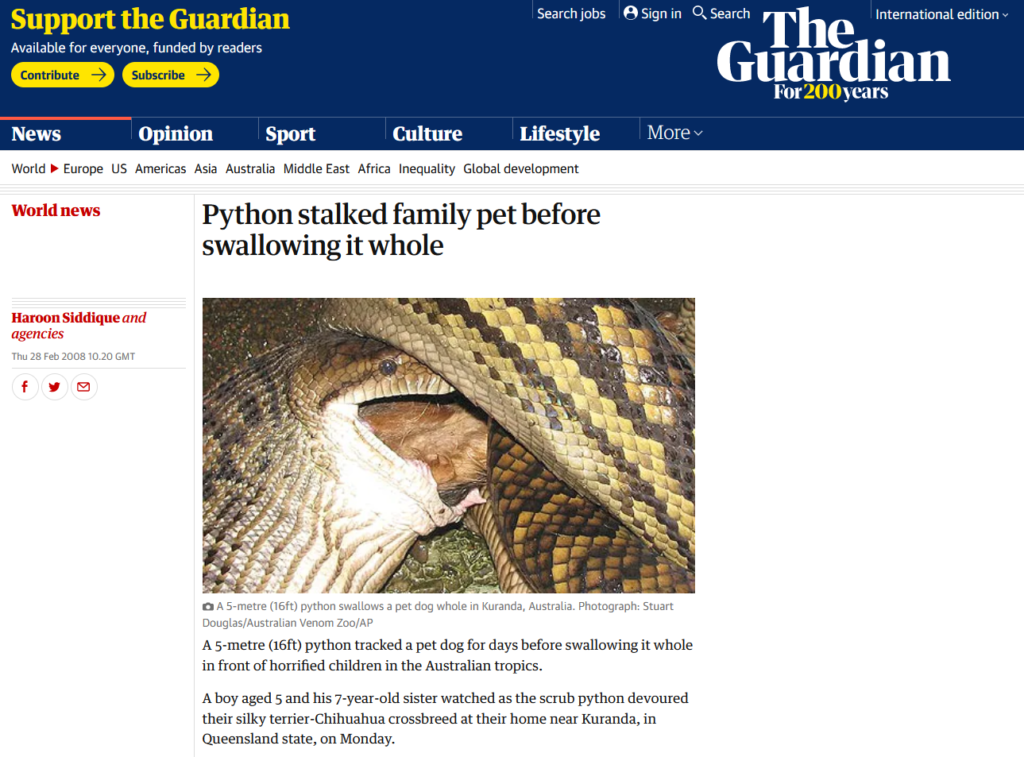An urban legend claims that a woman would have found her python spreading out its body from her head to her toes when she was in her bed. Far from being affectionate, her pet snake would have been trying to measure its owner before eating her:
Every single evening, the woman would sleep with her pet python sprawled her body. When she’d sleep on her stomach, her beloved python would spread out its body from her head to her toes. It was a bonding moment that she cherished with her snake. Until she noticed something was wrong.
After weeks of sleeping with the woman in her bed, the python suddenly stopped eating. She started to grow concerned and took the snake to the veterinarian to see why it was refusing meal times that it normally used to love.
[…]
After hearing that woman and the python sleep together every evening, the vet was completely taken aback. They asked the woman if the snake sprawls out along her body or curls up around her at times. She confirmed that that was the case.
The vet began to explain to the woman that the snake was actually sizing her up. Every time the snake was sprawling itself along her body, it was actually a bit of rehearsal of sorts. It was essentially practicing for its next big meal.
SBLY Animal Channel story. 10.31.17.
A Widespread Story
This story is widly known in France and in the USA. According to the urban legends website Snopes and Diane Morgan book’s on Snakes in Myth, Magic and History, it was already widespread in 2008. In Belgium and in France, this odd anecdote is mentioned by Télé Loisirs.fr, Le Démotivateur, Le Tribunal du Net, Newsner or Sud Presse and others popular and pure player medias from 2016 to 2019.
The French and the American versions are quite similar: the protagonist is always a woman and she owns a python or a boa. As in the “Chocking Doberman“, the story ends on the vet’s revelation.

Debunking a “Crazy Legend”
Whe asked Vincent Noël, a member of the Herpetological Society of France, passionate snake breeder and author of many books about reptiles, if this urban legend seems at least plausible. According to him, this story is “an old and crazy legend! Snakes evaluate their preys with their eyesight and, for some specific species, their facial pits.” According to this amateur naturalist, it is hard to imagine a snake spreading out its body to measure its prey before attacking it: “I don’t believe the prey would let it do it! The lying position is quite frequent in terrariums and in the wild: it can be interpreted as the sign of a relaxed state or a mean, for snakes, to regulate their internal temperature.” However, sleeping with a snake remains dangerous. “Snakes carry salmonella”, Vincent Noël observes. How can we explain the emergeance of such a crazy legend?
Snakes in Urban Legends
Snakes are common in urban legends. In these particular type of stories, they are always depicted as exotic and dangerous animals.
“The Snake in the Store”
In “The Snake in the store” (Brunvand, 2001 ; Campion-Vincent, 1989) they are, for example, hidden in imported goods, ready to bite the hand of a curious consumer. This urban legend was particularly widespread in the United States (1960s) and in France (1980s). Other stories about snakes appeared later in these two countries. Some of them pretend that “a child had been bitten by a snake (or snakes) hidden among the plastic balls at the ‘playland’ of a fast-food outlet.”
In similar urban legends, snakes are sometimes replaced by spiders. In “Spiders in the cactus” (Brunvand, 2001), these eight-legged animals are hidden inside exotic plants ready to be purchased.
Bosom Serpent Revisited
Snakes attacking their prey during their sleep are also present in the Occidental folklore. In a modern and very local version of the bosom serpent legend collected by Jan Harold Brunvand, a baby had, supposedly, “been fed some milk, then left sleeping by the side of the field while its mother picked strawberries. A snake, attracted by the smell of milk on the baby’s breath, crept up to the child and slithered down its throat, strangling the baby.”
Negative Symbolism of Snakes
These legends are widespread in an environment where snakes are barely present. And when it is the case, they fill up the newspapers “unusual facts” column. Their rarety partly explains why we both fear and admire them. However, their negative symbolism is a long story.
Serpents in the Bible

In Occident, this symbolism can, at least, be traced back to the Bible. In the Genesis, Eve is tempted by the serpent who convinced her to eat the forbidden fruit. The serpent is also mentioned by the Revelation (Revelation, 12:9) as the Devil, cast out by St-Michael:
And the great dragon was cast out, that old serpent, called the Devil, and Satan, which deceiveth the whole world: he was cast out into the earth, and his angels were cast out with him.
Revelation 12:9 (King James Bible)
From a human perspective, he is the temptation that lies dormant in everyone of us.
“The Villager and the Snake” (La Fontaine)

The danger of the snake is often associated with its alleged deviousness. In “The Villager and the Snake” by Jean de la Fontaine (1668), a snake dying from cold is saved by a villager who takes him in his house and places him by the fire. Once revived, the snake attacks him. Luckily, the villager reacts in time and “slice the Beast”.
A Cautionary Tale
The parallel between this La Fontaine’s fable and our urban legend is stricking: in the “Snake sizing up its owner” story, the protagonist is very attached to her snake. She probably think she has a special moment with her pet when she let it sleeping with her. She particularly cherish the moment when her snake “spread out its body from her head to her toes”. Acting this way, her cold-blooded animal, on the contrary, just plan to eat her. The gap between the woman’s interpretation and her animal true intentions is extreme and accentuated by the use of a feminine character. In the highly gendered world of urban legends, woman are associated with empathy, emotions, feelings and attachment ; qualities which are, in that particular story, synonyms with blindness.
The Risks of Adopting Wild Animals As Pets
The traditional representation of snakes is integrated in a modern cautionary tale about the risks of adopting wild animals as pets: a snake is not a cat or a dog and it doesn’t have the same attachment skills. Ignoring that and treating a snake as a domesticated animal or a human friend can lead us to a great danger. This legend is probably born with a recent fashion for terrariophilia. Even if adopting a snake at home is a practice which appeared in the XIXth century, it became popular only since the 1990s in France, as Vincent Noël explains it in Des reptiles ? Quelle horreur !.
Misunderstandings
“Attachment is linked with sociability and snakes are not social animals. They recognize their caretaker, mainly their smell, but it’s limited, observes Vincent Noël. “The reptilian ethology is, however, understudied, and some researches show that snakes are much more developed than previously thought.”
Anthropomorphising a snake can lead to mistakes that are especially harmful to the animal. Snakes need, for example, to feel safe in their environment when they sleep, and it’s not a good idea to keep them in our beds. A warm temperature is also necessary for their thermoregulation. And what we interpret as a sign of relaxation, such as a placid behavior, can actually be a sign of distress in these reptiles.
Accidents Remain Very Rare
Accidents that lead to death involving pythons or boas are highly mediatized. The story about a family dog swallowed by a python has travelled the world. However, their incidence is quite rare if we compare them to other risks such as dog’s attacks, even in the United States.

With pet snakes, bites are however common but not serious. Indeed, species available for captivity are inoffensives. “The ‘classic’ mistake is to put your hand in the terrarium after touching a rat, Vincent Noël explains, the hand has the size, the smell and the temperature of a rat. The snake can attack it but it will soon realises its mistake and release its bite.”
“As far as I know, no pet snake has ever eaten its caretaker. There have been some fatal attacks but they are very rare and no cases are known in France” concludes Vincent Noël.
Sources
Vincent Noël. 2016. Des reptiles? Quelle horreur!: Débarrassez-vous des préjugés sur les reptiles [lire en ligne]. Vincent NOEL – Tiliqua, le monde des lézards.
Anonymous. 2008. « Will Your Pet Snake “Measure” You Before Eating You? » Snopes.Com. Consulté 17 décembre 2019 (https://www.snopes.com/fact-check/snake-measure/).
Jan Harold Brunvand. 2002. Encyclopedia of Urban Legends. Sanata Barbara, Calif: Abc-clio.
Véronique Campion-Vincent. 1989. « Complots et avertissements: légendes urbaines dans la ville ». Revue Française de Sociologie 30(1):91.
“Les serpents de grands magasins” in Véronique Campion-Vincent & Jean-Bruno Renard. 1992. Légendes urbaines. Rumeurs d’aujourd’hui. Payot.
“Serpent” in Jean Chevalier, Alain Gheerbrant. 1984. Dictionnaire des symboles. Mythes, rêves, coutumes, gestes, formes, figures, couleurs, nombres.
David Emery. 2017. « The Case of the Choking Doberman ». LiveAbout. Consulté 17 décembre 2019 (https://www.liveabout.com/the-choking-doberman-3299147).
Mark A Mitchell. 2009. « CHAPTER 1 – HISTORY OF EXOTIC PETS ». P. 1‑3 in Manual of Exotic Pet Practice, édité par M. A. Mitchell et T. N. Tully. Saint Louis: W.B. Saunders.
Marc Pernot. 2019. « Le serpent qui donne la vie ». Oratoire du Louvre. Consulté 17 décembre 2019 (https://oratoiredulouvre.fr/libres-reflexions/predications/le-serpent-qui-donne-la-vie-nombres-21-jean-3).
“Revelation” in The King James Bible. Wikisource. Consulté 18 novembre 2021 (https://en.wikisource.org/wiki/Bible_(King_James)/Revelation).
In the French Medias
2019. « Tous les soirs, cette femme dormait avec son serpent. Puis un jour, il est tombé malade…elle l’a emmené chez le vétérinaire et a découvert quelque chose d’effrayant ! ». Tribunal du Net. (http://www.letribunaldunet.fr/animaux/soirs-cette-femme-dormait-serpent-puis-jour-tombe-malade-emmene-chez-veterinaire-a-decouvert-quelque-chose-deffrayant.html).
2018. « Elle dormait tous les soirs avec son serpent: une nuit, elle frôle le drame ». sudinfo.be. Consulté 17 décembre 2019 (https://www.sudinfo.be/id48987/article/2018-04-16/elle-dormait-tous-les-soirs-avec-son-serpent-une-nuit-elle-frole-le-drame).
2017. « Une femme dort avec son python tous les soirs : puis l’animal arrête de manger et le vétérinaire révèle l’horrible vérité ». Newsner Francais. Consulté 17 décembre 2019 (https://fr.newsner.com/animaux/histoire-drole-femme-dort-python-finit-regretter/).
2016. « Elle dort tous les soirs avec son serpent de compagnie, mais ce qu’elle va découvrir ensuite aurait pu lui coûter la vie ». Demotivateur. Consulté 17 décembre 2019 (https://www.demotivateur.fr/article/voici-comment-une-visite-chez-le-veterinaire-a-sauve-la-vie-a-cette-proprietaire-de-python–5099).
2016. « Elle dormait avec son python… un geste simple lui a sauvé la vie (VIDEO) ». Consulté 17 décembre 2019 (https://fr.news.yahoo.com/dormait-python-geste-simple-a-sauv%C3%A9-vie-video-170006085.html).
2011. « Un boa veut manger sa maîtresse ?? » lapassiondesreptiles.forumactif.com. Consulté 17 décembre 2019 (http://lapassiondesreptiles.forumactif.com/t21529-un-boa-veut-manger-sa-maitresse).
